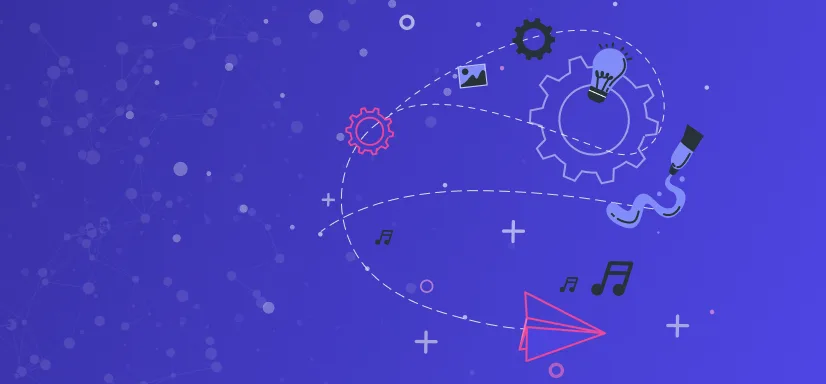- Content,
- MACH
5 Headless CMS Benefits: Reasons to Switch to Headless


In today's digital world, businesses and organizations are constantly looking for ways to improve their online presence and engage with their audience. A content management system (CMS) is an essential tool for managing digital content, but the traditional CMS architecture has limitations that can hinder innovation and growth.
Enter headless CMS.
This new approach to content management separates the front-end presentation layer from the back-end content storage and management.
By decoupling the two layers, a headless CMS provides greater flexibility, scalability, and speed, as well as improved security.
In this article, we will explore the benefits of a headless CMS and why businesses should consider making the switch. From improved website and app performance to cost savings, we will examine how headless CMS can streamline content creation and delivery while also providing a better user experience.
What Is Headless Architecture?
Headless architecture is an approach to content management that separates the front-end presentation layer from the back-end content storage and management.
This means that the content can be created, stored, and managed without being tied to a specific presentation layer.
With headless architecture, the content can be delivered to any device or platform, making it more flexible and scalable. This approach can also improve the website and app performance, as well as enhance security.
What Is a Headless CMS?
Headless CMS is a content management system architecture that separates the front-end presentation layer from the back-end content storage and management.
This approach provides greater flexibility, scalability, and speed, as well as improved security.
Benefits of Headless CMS Solutions
Headless CMS Can Help with Flexibility
Headless CMS provides a great deal of flexibility in content creation and delivery.
Traditional CMSs are built with an integrated front-end presentation layer that is tightly coupled with the back-end content storage and management system. This means that content creators are limited in terms of the types of content they can create and how they can deliver it to various devices or platforms.
With headless CMS, content creators can create content without worrying about the presentation layer and then deliver it to any device or platform through APIs.
This flexibility is particularly useful for businesses that need to deliver content to multiple platforms or devices.
For example, a news website may need to deliver content to a website, mobile app, and social media channels. With a headless CMS, the content can be created once and then delivered to each platform or device in the appropriate format. This saves time and resources while also ensuring that the content is consistent across platforms.
Moreover, headless CMSs allow businesses to experiment with new presentation technologies without having to rebuild the entire CMS architecture. Since the presentation layer is completely separate from the back end, businesses can quickly and easily make changes to the front end without affecting the back-end content storage and management system. This enables businesses to stay up-to-date with the latest presentation trends and technologies and to deliver a better user experience.
Headless CMSs Can Improve Website and App Performance
Headless CMSs can significantly improve the website and app performance by separating the front-end presentation layer from the back-end content storage and management.
In traditional CMS architectures, the front-end presentation layer and the back-end content storage and management are tightly coupled, which means that any changes to the front end can affect the back end and vice versa. This coupling can lead to slower performance and a lack of flexibility in terms of content creation and delivery.
With headless CMS, the front-end presentation layer is completely decoupled from the back-end content storage and management, which means that content can be delivered directly to the user's device without needing to go through an intermediary layer. This reduces the amount of time it takes for content to load, resulting in a faster and more responsive website or app.
Moreover, headless CMSs allow for the use of modern technologies, such as static site generators and content delivery networks. Static site generators can pre-build and cache pages, which can significantly reduce the time it takes to load content. Content delivery networks can cache content in servers around the world, which means that content can be delivered from the server closest to the user, further reducing the time it takes for content to load.
Another way that headless CMS can improve website and app performance is by enabling businesses to experiment with new presentation technologies without having to rebuild the entire CMS architecture. Since the presentation layer is completely separate from the back end, businesses can quickly and easily make changes to the front end without affecting the back-end content storage and management system. This enables businesses to stay up-to-date with the latest presentation trends and technologies while maintaining optimal website and app performance.
Overall, headless CMS can significantly improve the website and app performance by separating the front-end presentation layer from the back-end content storage and management, allowing for the use of modern technologies, and enabling businesses to experiment with new presentation technologies without affecting performance.
Headless CMS Can Improve the Security
Headless CMS offers improved security benefits because it separates the front-end presentation layer from the back-end content storage and management. This approach makes it more difficult for hackers to gain access to the back-end content storage and management system, as sensitive data and code are kept separate from the front-end presentation layer.
Moreover, headless CMS can provide more robust security features and protocols than traditional CMSs. For example, headless CMS often offers strong encryption and secure API connections, which can help protect against data breaches and other security threats. Additionally, headless CMSs can provide better control over user access and permissions, allowing administrators to restrict access to sensitive data and functionality.
Headless CMS can also improve security by enabling businesses to quickly and easily deploy security updates and patches. Since the presentation layer is separate from the back-end content storage and management system, businesses can update the front-end presentation layer without affecting the back-end system. This means that security updates can be deployed more quickly and efficiently.
Furthermore, headless CMSs can provide better protection against distributed denial of service (DDoS) attacks. By using a content delivery network (CDN), headless CMS can distribute content across multiple servers and locations, making it more difficult for attackers to launch a successful DDoS attack. Additionally, by using a CDN, headless CMS can cache content in servers around the world, allowing for faster content delivery and reducing the load on any single server.
Overall, headless CMS can provide better security benefits than traditional CMSs by separating the front-end presentation layer from the back-end content storage and management, offering more robust security features and protocols, enabling quick and easy deployment of security updates, and providing better protection against DDoS attacks.
Headless CMS Can Easily Be Scalable
Headless CMSs are highly scalable, which is one of their key benefits.
Traditional CMSs are often limited in terms of their scalability because of their tightly coupled architecture. When the front-end presentation layer is tightly coupled with the back-end content storage and management, scaling the CMS can be challenging.
With headless CMS, the front-end presentation layer is decoupled from the back-end content storage and management, which makes it easier to scale the system. Since the content can be created and stored separately from the presentation layer, businesses can add or remove presentation layers as needed to accommodate changes in traffic or usage patterns. This means that businesses can easily scale up or down based on their needs without having to worry about the underlying content management system.
Another way that headless CMSs can improve scalability is by enabling businesses to integrate with other systems and applications more easily. Because the content is stored separately from the presentation layer, businesses can more easily integrate with other systems and applications without worrying about compatibility issues. This can help to streamline workflows and improve productivity, which can be particularly useful for businesses that have complex or dynamic content management needs.
Moreover, headless CMSs allow businesses to create content that is easily reusable and shareable across multiple platforms and devices. This means that businesses can create content once and then deliver it to multiple platforms and devices, which can save time and resources while also improving consistency and quality. By creating reusable content, businesses can scale their content creation efforts more efficiently and effectively without having to create new content for each platform or device.
Overall, headless CMSs are highly scalable and can provide businesses with the flexibility and agility they need to grow and adapt to changing market conditions. By separating the front-end presentation layer from the back-end content storage and management, headless CMSs enable businesses to scale their content creation and delivery efforts more easily and efficiently. This can help businesses to improve their online presence and engage with their audience more effectively.
Headless CMS Can Improve Content Distribution Across Platforms
Headless CMSs can significantly improve content distribution across platforms by enabling businesses to create content once and then deliver it to multiple platforms and devices.
Traditional CMSs are built with an integrated front-end presentation layer that is tightly coupled with the back-end content storage and management system. This means that content creators are limited in terms of the types of content they can create and how they can deliver it to various devices or platforms.
With headless CMS, content creators can create content without worrying about the presentation layer and then deliver it to any device or platform through APIs.
This means that businesses can create content once and then deliver it to multiple platforms and devices, which can save time and resources while also improving consistency and quality.
By creating reusable content, businesses can scale their content creation efforts more efficiently and effectively without having to create new content for each platform or device. This is particularly useful for businesses that need to deliver content to multiple platforms or devices, such as news websites that need to deliver content to a website, mobile app, and social media channels.
Moreover, headless CMSs can help businesses to create personalized experiences for their users by delivering content that is tailored to each user's preferences and behavior. By using data and analytics, businesses can gain insights into their users' behavior and preferences and then use this information to deliver content that is more relevant and engaging. This can help businesses to improve their online presence and engage with their audience more effectively.
Another way that headless CMSs can improve content distribution across platforms is by enabling businesses to integrate with other systems and applications easily. Because the content is stored separately from the presentation layer, businesses can more easily integrate with other systems and applications without worrying about compatibility issues. This can help to streamline workflows and improve productivity, which can be particularly useful for businesses that have complex or dynamic content management needs.
Overall, headless CMSs can significantly improve content distribution across platforms by enabling businesses to create content once and then deliver it to multiple platforms and devices, by helping businesses to create personalized experiences for their users, and by enabling businesses to integrate with other systems and applications easily. By improving content distribution, businesses can improve their online presence and engage with their audience more effectively, which can help to drive growth and success in today's digital world.
Drawbacks of a Headless CMS
Content Preview Can Be Challenging with a Headless CMS
Content preview can be challenging with headless CMSs because the front-end presentation layer is completely decoupled from the back-end content storage and management. This means that content creators may not be able to see how the content will be presented to the end users before it is actually published.
In traditional CMSs, the content creators can preview the content before publishing it to ensure that it looks and functions as intended. With headless CMSs, however, content creators may need to rely on a separate preview system or use a live preview feature, which may not accurately reflect the final presentation of the content.
This can make it difficult for content creators to ensure that the content is being presented in the way they intended and may require more testing and tweaking before it is published.
Headless CMS Requires More Technical Expertise than Traditional CMSs
Headless CMSs require more technical expertise than traditional CMSs because they have a more complex architecture. Since the front-end presentation layer is decoupled from the back-end content storage and management, developers need to have a good understanding of APIs and how to use them to deliver content to different platforms and devices.
In addition, headless CMSs often require the use of modern technologies, such as static site generators, which can be more complex to set up and maintain than traditional CMSs.
Overall, headless CMSs require developers to have a more specialized skill set and a deeper understanding of the underlying technologies, making them more challenging to implement and maintain compared to traditional CMSs.
The Bottom Line: Why It's Important to Consider Using a Headless CMS Solution?
Headless CMS is an approach to content management that separates the front-end presentation layer from the back-end content storage and management. This approach provides greater flexibility, scalability, and speed, as well as improved security. Headless CMSs offer several benefits for businesses and organizations that need to manage digital content.
One of the main benefits of headless CMS is its flexibility in content creation and delivery. With headless CMS, content creators can create content without worrying about the presentation layer and then deliver it to any device or platform through APIs.
Headless CMSs can also significantly improve the website and app performance by separating the front-end presentation layer from the back-end content storage and management. This reduces the amount of time it takes for content to load, resulting in a faster and more responsive website or app. Moreover, headless CMSs allow for the use of modern technologies, such as static site generators and content delivery networks, which can further improve performance.
Another benefit of headless CMS is improved security. By separating the front-end presentation layer from the back-end content storage and management, a headless content management system makes it more difficult for hackers to gain access to the back-end system. Additionally, headless CMSs often offer strong encryption and secure API connections, which can help protect against data breaches and other security threats.
Headless CMS and Personalization & Experimentation
Headless content management systems also offer businesses the ability to create personalized experiences for their users.
By using data and analytics, businesses can gain insights into their users' behavior and preferences and then use this information to deliver content that is more relevant and engaging. This can help businesses to improve their online presence and engage with their audience more effectively.
Moreover, headless CMSs allow businesses to experiment with new presentation technologies without having to leave their headless CMS dashboard.
Overall, headless CMSs are future-proof and provide businesses with the flexibility and agility they need to grow and adapt to changing market conditions.
By enabling businesses to create personalized experiences and experiments, headless CMSs help businesses to improve their online presence and engage with their audience more effectively.
If you're interested in learning more about how headless CMSs can benefit your business, check out our related posts on the topic.
Frequently Asked Questions About Headless CMS Benefits
Why Is Headless Faster?
Headless CMSs are faster because they separate the front end from the back end. This means that content can be delivered directly to the user's device without needing to go through an intermediary layer. This reduces the amount of time it takes for content to load, resulting in a faster and more responsive website or app.
Additionally, headless CMSs allow for the use of modern technologies, such as static site generators and content delivery networks, which can further improve the website and app speed.
Is Headless CMS SEO-Friendly?
Yes, headless CMS can be SEO-friendly if implemented properly. Since headless CMS allows for more flexibility and control over the content, it can help improve SEO by allowing for the optimization of metadata, URLs, and other on-page elements.
Additionally, headless CMS can improve website speed, which is a crucial ranking factor for search engines.
However, it's important to note that the implementation of SEO best practices still relies on the expertise of the content creators and developers.
Is Headless CMS More Secure?
Headless CMS can be more secure than traditional CMSs because it separates the front end from the back end, which means that sensitive data and code are kept separate. This can make it more difficult for hackers to gain access to the backend and compromise the system.
Additionally, headless CMSs often have more robust security features and protocols in place, such as strong encryption and secure API connections.
However, as with any system, the security of a headless CMS ultimately depends on how it is implemented and maintained. It is important to follow best practices for security and regularly update and monitor the system to ensure optimal security.
Learn everything you need to know about MACH architecture

